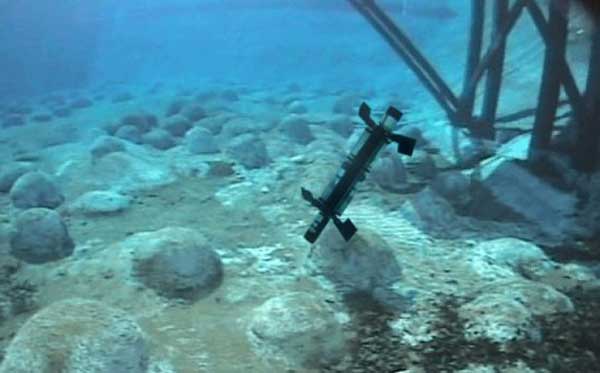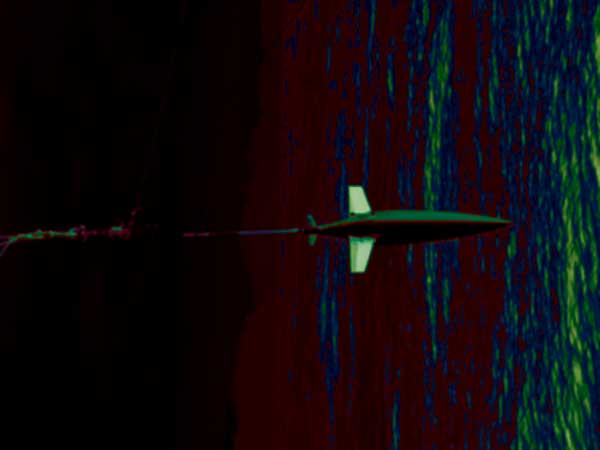12/09/2011 – In a wide ranging discussion with General Heinz, former PEO of the F-35 program and now head of Maritime Systems in I Robot (and working for the former head of NAVAIR, now the COO of I Robot), the current state of Maritime Robotic systems was discussed as well as their prospects.
According to Heinz, three Seaglider robotic systems were used in the Gulf Oil spill crisis.
First Heinz explained how Seaglider works.
Seaglider is a long endurance vehicle that uses a change in its buoyancy as a means of propulsion. And so when the Glider is positively going, it stays at the surface. It sticks its antenna out of the water and is able to communicate via iridium satellite to a home-based station where the pilot/operator can see the data that has been retrieved from the last dive and then type in new commands relative to the Glider operation. If for whatever reason the Glider doesn’t make contact during that, then it has a profile that it’s basically commanded to fly and it will continue flying that profile. So if there’s bad weather and you can’t get to iridium, then the Glider doesn’t get stuck in the bad weather, it goes ahead and continues its mission. But it then begins to pump negatively in terms of its buoyancy and then flies just like a regular glider would with the wings steering — doing command changes and essentially going negative buoyancy to the depth that you want to do, sampling with whatever sensors you put onboard at whatever rate you require and can continue to do that for up to nine months without human intervention.
Then Heinz explained how it was used in the Gulf.
What we did in the Gulf is we took a couple science sensors because at the time we didn’t have a carbon detector, but we used a combination of a turbidity and a fluorometer, which are essentially biomass sensors, and use some techniques that had been developed in the science regime to actually prove that we could detect the oil when we were passing through it. And so the Glider was put out near the accident to actually go down into the water column and try to find the underwater plumes. And frequently the Seagliders, there were three of them deployed total, one from us and two from the US Navy, were the only things that were able to track where the underwater plumes were moving to because the space satellites of other ship sampling methods were too slow or simply unable to make the observation in the water column. Now we would’ve preferred to be able to do that to deeper than 3,300 feet, but that’s the current limits of the capability that we deliver, down to a thousand meters or 3,300 feet.
The company is focusing significant attention on applications of the Seaglider as well as underwater robotic developments and opportunities.
I also think is a fallacy of the current thinking is that most of it in terms of underwater robots is centered almost entirely around duration or ability to move covertly to a location. So the large diameter UUV program and others are building these very large vehicles that have separate power systems and lots of storage for batteries simply because it’s believed you’re going to drop these things in waters and they’re going to have to travel 200 miles by themselves covertly in order to begin to be able to perform the mission that you’re looking for. And I would simply propose that either that concept or an air deployable one, but the reality is we want to start moving to a number of smaller robots that can populate that grid and do so by delivering them near the site and then allowing the persistence of the mission to fill in those gaps and whether that’s an air deployable system or it’s a mother ship that then carries them a number of smaller robots that are deployed at intervals, but we have to start thinking about what those smaller robots are going to do for us and what persistence that they want to have. So the simplest mission or challenge might actually be: How you going to blow up mines in the surf, and what’s the means that you’re going to do to deliver those and dolphins probably is not the answer.
 Expandable and adaptable, the iRobot® Transphibian™ supports a wide variety of defense, first responder and commercial applications. Transphibian is capable of swimming long distances and is difficult to detect; the robot swims submerged to its destination, guided by periodic GPS updates. (Credit: iRobot)
Expandable and adaptable, the iRobot® Transphibian™ supports a wide variety of defense, first responder and commercial applications. Transphibian is capable of swimming long distances and is difficult to detect; the robot swims submerged to its destination, guided by periodic GPS updates. (Credit: iRobot)
And Heinz sees the deployment of the Littoral Combat Ships and the new LPDs as a significant opportunity to deploy such robotic elements onboard. “These new ships are going to be ideal deployers of robotic systems and will indeed need them to extend ship protection forward and downward.”
Heinz also underscored the light logistical footprint, which underwater robotic systems would need.
I believe that robots in the underwater domain are different than air in the fact that the human logistics chain is less expensive for underwater robots, that I don’t have to maintain that very large human back train for a UAV. I don’t have to do that for a UUV and so there is potential for savings beyond just the functionality that the robot provides.


